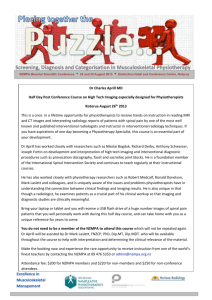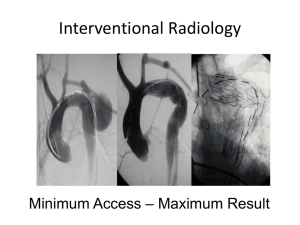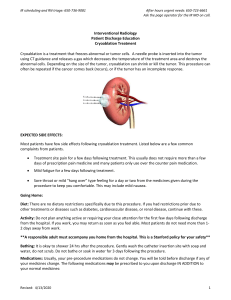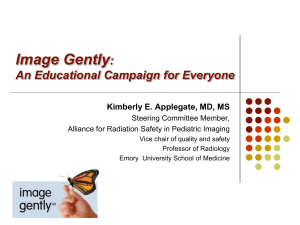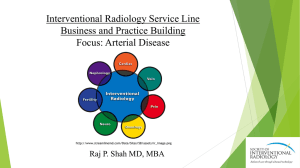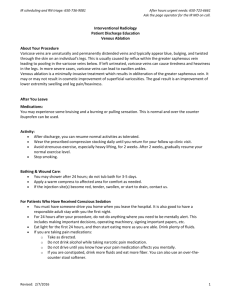Application Guidelines for Early Specialization in
advertisement
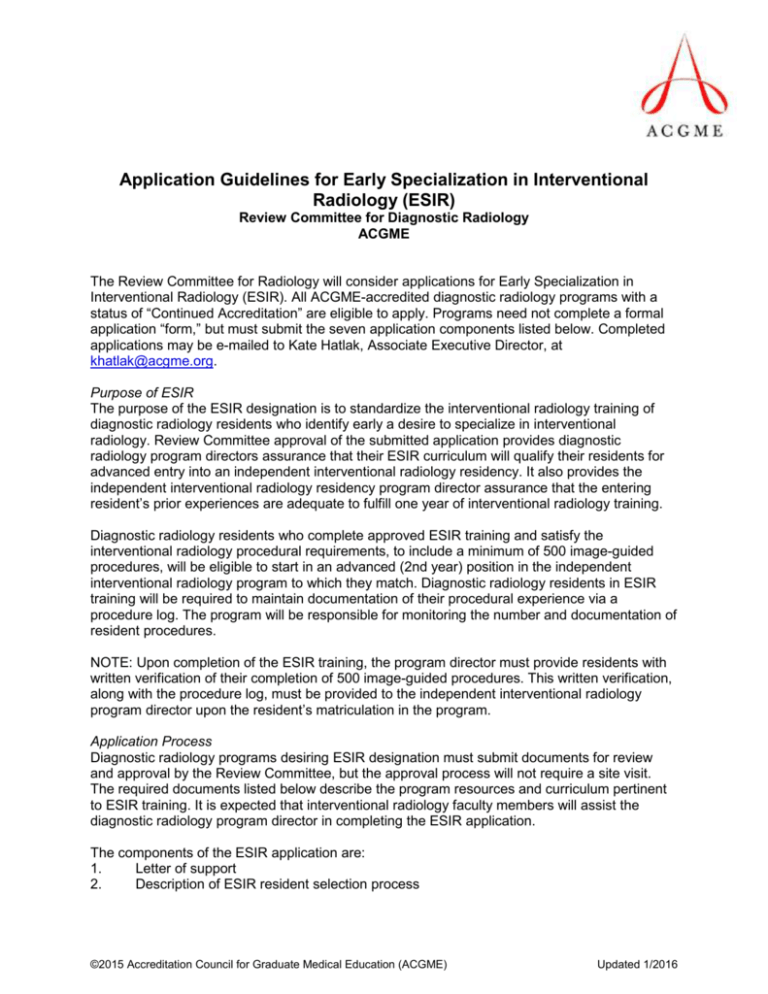
Application Guidelines for Early Specialization in Interventional Radiology (ESIR) Review Committee for Diagnostic Radiology ACGME The Review Committee for Radiology will consider applications for Early Specialization in Interventional Radiology (ESIR). All ACGME-accredited diagnostic radiology programs with a status of “Continued Accreditation” are eligible to apply. Programs need not complete a formal application “form,” but must submit the seven application components listed below. Completed applications may be e-mailed to Kate Hatlak, Associate Executive Director, at khatlak@acgme.org. Purpose of ESIR The purpose of the ESIR designation is to standardize the interventional radiology training of diagnostic radiology residents who identify early a desire to specialize in interventional radiology. Review Committee approval of the submitted application provides diagnostic radiology program directors assurance that their ESIR curriculum will qualify their residents for advanced entry into an independent interventional radiology residency. It also provides the independent interventional radiology residency program director assurance that the entering resident’s prior experiences are adequate to fulfill one year of interventional radiology training. Diagnostic radiology residents who complete approved ESIR training and satisfy the interventional radiology procedural requirements, to include a minimum of 500 image-guided procedures, will be eligible to start in an advanced (2nd year) position in the independent interventional radiology program to which they match. Diagnostic radiology residents in ESIR training will be required to maintain documentation of their procedural experience via a procedure log. The program will be responsible for monitoring the number and documentation of resident procedures. NOTE: Upon completion of the ESIR training, the program director must provide residents with written verification of their completion of 500 image-guided procedures. This written verification, along with the procedure log, must be provided to the independent interventional radiology program director upon the resident’s matriculation in the program. Application Process Diagnostic radiology programs desiring ESIR designation must submit documents for review and approval by the Review Committee, but the approval process will not require a site visit. The required documents listed below describe the program resources and curriculum pertinent to ESIR training. It is expected that interventional radiology faculty members will assist the diagnostic radiology program director in completing the ESIR application. The components of the ESIR application are: 1. Letter of support 2. Description of ESIR resident selection process ©2015 Accreditation Council for Graduate Medical Education (ACGME) Updated 1/2016 3. 4. 5. 6. 7. Block diagram showing the proposed interventional radiology curriculum along with an explanation of interventional radiology-related rotation activities Categories of planned procedural experience Estimate of the total volume of interventional radiology procedures for an ESIR resident. Attestation that the interventional radiology section is currently providing clinical care in the outpatient clinic setting and inpatient consultations. List of interventional radiology faculty members with qualifications, to include faculty members who will be providing training for interventional radiology-related rotations. Detailed Information Information regarding each of these components is provided below. 1. Letter of support: A letter of support for the ESIR program should be signed by the program director of the diagnostic radiology residency program, designated institutional official (DIO), radiology department chairman, and either the chief of the interventional radiology division, program director of the interventional training program, or the designated educational director of the interventional service. The letter must also include attestation of sufficient procedural resources to provide all residents including other resident rotators and subspecialty fellows (or interventional radiology residents) with a sufficient breadth and balance of procedural experience in the essential areas. 2. Description of the ESIR Resident Selection Process: The diagnostic radiology program director should describe the method for ESIR resident selection. This should include an estimate of the number of ESIR residents anticipated each year. The Review Committee would like to be assured that the selection process is conducted in a manner that is clear and transparent to residents. 3. Block diagram showing the proposed IR curriculum along with an explanation of IRrelated rotation activities: ESIR training requires a total of 11 interventional radiology or interventional radiology-related rotations (minimum of 44 weeks), and an ICU rotation of at least four continuous weeks within the four-year diagnostic radiology residency. The interventional radiology education in the PGY2-4 should be included in the ESIR curriculum. An interventional radiology-related rotation is a training experience that does not take place within the interventional radiology division and is not supervised by qualified interventional radiologists. Interventional radiology-related rotations are intended to provide the resident with experience and training in core interventional radiology procedures that are performed outside of the interventional radiology section or to provide additional clinical or procedural experience relevant to interventional radiology. Of the 11 required interventional radiology or interventional radiology-related rotations, it is expected that at least eight rotations (minimum of 32 weeks) will take place in the interventional radiology section under the supervision of interventional radiology faculty members. One rotation (four continuous weeks) should take place in the ICU. Generally, there will be three interventional radiology rotations (four-week blocks) in the first 36 months of diagnostic radiology residency, but more than three interventional radiology or interventional radiologyrelated rotations in the PGY-2-4 are allowed at the discretion of the diagnostic radiology program director. NOTE: The Review Committee has determined that mammography does not count as an interventional radiology-related rotation. ©2015 Accreditation Council for Graduate Medical Education (ACGME) Updated 1/2016 Summary The minimum ESIR requirements are: at least eight interventional radiology rotations, one ICU rotation, and up to three interventional radiology-related rotations during the PGY-2-5. An ESIR curriculum may include more rotations in interventional radiology, up to a maximum of 16 as allowed in the Program Requirements for Diagnostic Radiology. A. Please provide a block diagram that highlights the interventional radiology and interventional radiology-related rotations, including the ICU rotation, during the PGY-2-5. An example is shown in Appendix 1. B. For all interventional radiology-related rotations and the ICU rotation, provide additional information, including: - a copy of the goals and objectives for each rotation; and, - an estimate of the number and type of interventional radiology procedures that will apply toward the interventional experience. Sample documentation is provided in Appendix 2. 4. Categories of Planned Procedural Experience: Complete a table indicating the procedural areas that will constitute the residents’ experience with interventional radiology and interventional radiology-related procedures. A table of interventional radiology procedural categories is provided in Appendix 3. 5. Procedural Volume: Indicate the expected total volume of interventional radiology and interventional radiology-related procedures performed by an ESIR resident. This includes the total number of procedures over four years of training. Note that a minimum of 500 interventional radiology or interventional radiology-related procedures is required for entry into the second year of an independent interventional radiology residency. 6. Attestation of Interventional Radiology Clinical Services: Provide attestation that the interventional radiology service at your institution is currently (over the most recent 12-month period) providing clinical care in the form of outpatient clinics and in-patient clinical consultations. 7. List of Interventional Radiology Faculty Members with Qualifications: Complete a table listing the names and qualifications of the faculty members who will be responsible for education in interventional radiology and interventional radiology-related rotations. This must include evidence of each faculty member’s qualifications to provide interventional radiology training. This could include, but is not limited to, ABR VIR subspecialty certification, interventional radiology-related training in non-radiology specialties, or clinical and academic focus on imageguided procedures evidenced by clinical and research experience. A table is provided in Appendix 4. Appendices 1. Block diagram of the proposed interventional radiology curriculum (sample provided). 2. Goals and objectives for interventional radiology-related rotations (sample provided). 3. Categories of planned procedural experience for ESIR residents (programs should enter information directly into this table and submit it as part of the application documents). 4. Interventional radiology and interventional radiology-related faculty member names and qualifications (programs should enter information directly into this table and submit it as part of the application documents). ©2015 Accreditation Council for Graduate Medical Education (ACGME) Updated 1/2016 Appendix 1. Block Diagram of Proposed Interventional Radiology Curriculum (Sample) You may submit the block diagram that is currently uploaded to the Accreditation Data System (ADS) with the Early Specialization in Interventional Radiology (ESIR) resident rotations highlighted (i.e., modify your current rotation block diagram, indicating the expected rotations with which an ESIR resident will be involved by highlighting them). Vacation is taken during rotations. This is tracked to ensure that adequate experience occurs in all subsections of radiology and that requirements in nuclear medicine, mammography, and ESIR are met. ©2015 Accreditation Council for Graduate Medical Education (ACGME) Updated 1/2016 Appendix 2. Goals and Objectives for Interventional Radiology-Related Rotations (Sample) Background As per the Program Requirements for Diagnostic Radiology, each assignment must have competency-based goals and objectives. For the purposes of the ESIR application, a more simplified, abbreviated version of the goals and objectives may be submitted. However, this abbreviated version does not replace the need for the actual competency-based goals and objectives necessary for the rotation per requirement IV.A.2. Interventional radiology-related rotations Training in the domain of interventional radiology may be obtained outside of the interventional radiology section-proper. Such training is termed “interventional radiology-related.” Rotations providing a resident with image-guided procedural skills or clinical care experience falling within the domain of interventional radiology may qualify as interventional radiology-related. Examples of interventional radiology-related rotations include: Rotations outside of the Radiology Department Clinical rotation on the vascular surgery service with exposure to and procedural experience in the management of peripheral vascular disease Clinical rotation in medical oncology or hepatology with exposure to clinical management of oncology patients or patients with advanced liver disease Rotations within Radiology outside of Interventional Radiology A procedural body imaging rotation centered on the imaging/patient care/procedures related to abdominopelvic biopsy, drainage, ablation, or other intervention o One option would be for this resident to act as the key person to manage modality choice for patients in need of the image-guided interventions mentioned. A chest imaging rotation focused on the imaging/patient care/procedures related to thoracic disease such as biopsy, thoracentesis, or lung cancer ablation A musculoskeletal intervention rotation centered on the imaging/patient care/procedures related to musculoskeletal disease (e.g., joint aspiration/injection, tumor ablation, arthrography). (NOTE: The Review Committee has determined that mammography does not count as an IRrelated rotation) Sample Goals and Objectives for Interventional Radiology-Related Rotations and ICU Rotation Two examples of goals and objectives for interventional radiology-related rotations that fulfill the ESIR application requirements are provided on the next two pages. ©2015 Accreditation Council for Graduate Medical Education (ACGME) Updated 1/2016 Example 1 Abbreviated Goals and Objectives for an Interventional Radiology-Related Rotation Goals and Objectives: Rotation Name/Designation: Interventional radiology-related rotation Body Procedure Description of Rotation: This is a four-week rotation within the Diagnostic Radiology Body Imaging section. Dr. I. Du-Proc is the Section Head and oversees the rotation. Drs. A. Stick and R. U. Reddy also supervise residents for procedures. Goals: Develop ability to assess patient and imaging in preparation for computed tomography (CT)- or ultrasound-guided body interventions Develop competency in image-guided body interventions Gain proficiency in post-procedure care of patient Objectives: Complete pre-procedure workup of patients to undergo image-guided body interventions during the four-week rotation. Perform image-guided biopsies, parentheses, and drainages of the abdominal cavity during the rotation. Complete post-procedure care and follow-up of patients that have undergone imageguided procedures, including documentation of procedure, dictations and clinic notes, and medical record orders. Expectations: During the four-week rotation, the ESIR resident should be involved with all daily imageguided procedures. On average the resident should expect to perform six-to-10 parentheses; four-to-eight abdominal cavity biopsies; and two-to-six drainage catheter placements. Additional potential procedures include renal and biliary catheter placements. The resident must preview and work up all patients undergoing these procedures, as well as enter appropriate pre- and post-procedure orders and notes. When not involved with procedures or procedure workup, the resident is expected to review, interpret, and staff out abdominal CT studies with appropriate faculty members. ©2015 Accreditation Council for Graduate Medical Education (ACGME) Updated 1/2016 Example 2 Abbreviated Goals and Objectives for an Interventional Radiology-Related Rotation Goals and Objectives: Rotation Name/Designation: Interventional radiology-related rotation Neuro-interventional Description of rotation: This is a four-week rotation within the Diagnostic Radiology Neuroradiology section. Dr. Smart is the Section Head and oversees the rotation. Drs. Hacker and Luc also supervise residents for procedures. Goals: Develop ability to assess patient and imaging in preparation for neuroradiologic interventions Develop venous access and catheter skills Gain proficiency in post-procedure care of patient Objectives: Complete pre-procedure workup of patients to undergo neuro-interventions during the four-week rotation. Assist on and perform cervical and intracranial angiography, with experiences in venous access, aortic and carotid catheterization, catheter and wire exchange, and hemostasis control. Complete post-procedure care and follow-up of patients that have undergone imageguided procedures, including documentation of procedure, dictations, and clinic notes, and medical record orders. Expectations: During the four-week rotation, the ESIR resident should be involved with daily imageguided procedures. On average the resident should expect to perform approximately 15 venous access procedures; 10-15 aortic and/or carotid catheter studies; and be assistant to approximately 10 intracranial interventions, including aneurysm coiling, embolization, or stent placements. The resident must preview and work up patients undergoing these procedures, as well as enter appropriate pre- and post-procedure orders and notes. When not involved with procedures or procedure workup, the resident is expected to review, interpret, and staff out CT and magnetic resonance imaging (MRI) vascular studies with appropriate faculty members. ©2015 Accreditation Council for Graduate Medical Education (ACGME) Updated 1/2016 Appendix 3. Categories of Planned Interventional Radiology Procedural Experience Invasive Imaging and Interventional Procedures Non-Invasive Vascular Imaging CTA/MRA Abdomen/Pelvis CTA/MRA Extremities CTA/MRA Chest Lower Extremity Arterial Segmental Evaluation Angiography Carotid/Cerebral Arteriography Extremity Arteriography Mesenteric/Renal Arteriography Dialysis Graft/Fistula Evaluation Anticipated ESIR Resident Experience (Y/N) Choose an item. Choose an item. Choose an item. Choose an item. Choose an item. Choose an item. Choose an item. Choose an item. Arterial Vascular Intervention Arterial Angioplasty Arterial Stent Placement Lower Extremity Arterial Revascularization Peripheral Thrombolysis/Thrombectomy Embolization (Any) Aortic Stent Graft Carotid Stent Placement Stroke Thrombolysis Choose an item. Choose an item. Choose an item. Choose an item. Choose an item. Choose an item. Choose an item. Choose an item. Choose an item. Choose an item. Choose an item. Venous Vascular Interventions TIPS Port Placement Tunneled Catheter Placement IVC Filter Placement Venous Ablation Venous Thrombolysis Hemodialysis Intervention Choose an item. Choose an item. Choose an item. Choose an item. Choose an item. Choose an item. Choose an item. Non-Vascular Intervention Biopsy Chest Tube Placement Nephrostomy/Nephroureteral Tube Placement Choose an item. Choose an item. Choose an item. TACE Radioembolization UFE ©2015 Accreditation Council for Graduate Medical Education (ACGME) Updated 1/2016 Invasive Imaging and Interventional Procedures Biliary Drainage Catheter Placement Percutaneous GI Tract Tube Placement Abscess Drainage Tumor Ablation Vertebroplasy/Kyphoplasty Paracentesis/Thoracentesis Clinical Activities Inpatient Interventional Radiology Admissions by Interventional Radiology Service (to include 23-hour stay) New Outpatient Interventional Radiology Clinic Visits ©2015 Accreditation Council for Graduate Medical Education (ACGME) Anticipated ESIR Resident Experience (Y/N) Choose an item. Choose an item. Choose an item. Choose an item. Choose an item. Choose an item. Choose an item. Choose an item. Updated 1/2016 Appendix 4. Interventional Radiology and Interventional Radiology-Related Faculty Names and Qualifications Faculty Member Name ABMS Board Certified (Y/N)? If Yes, include Specialty/ Name of Subspecialty Area Certificate ©2015 Accreditation Council for Graduate Medical Education (ACGME) Other Qualifications to Teach Interventional Radiology Updated 1/2016
